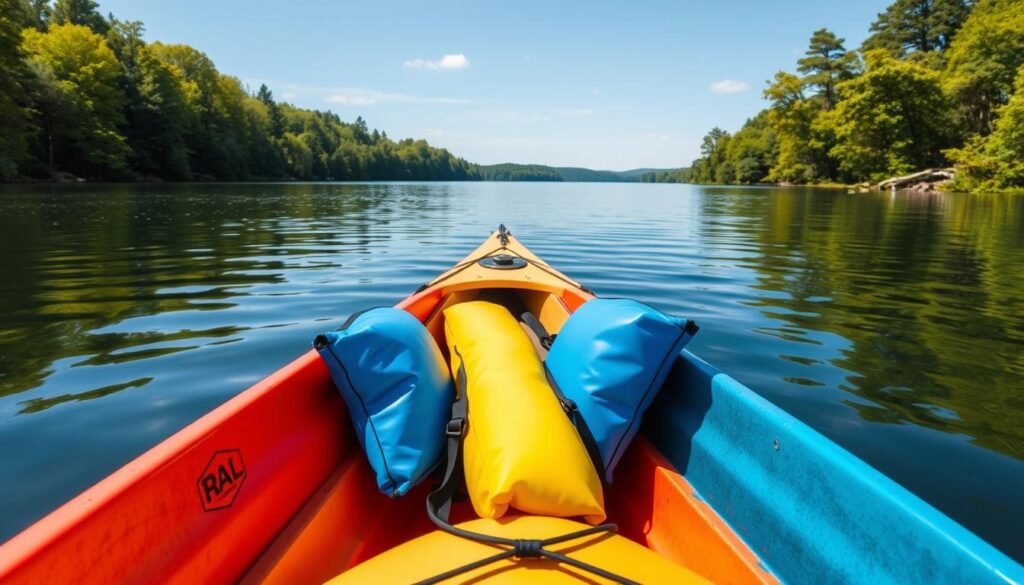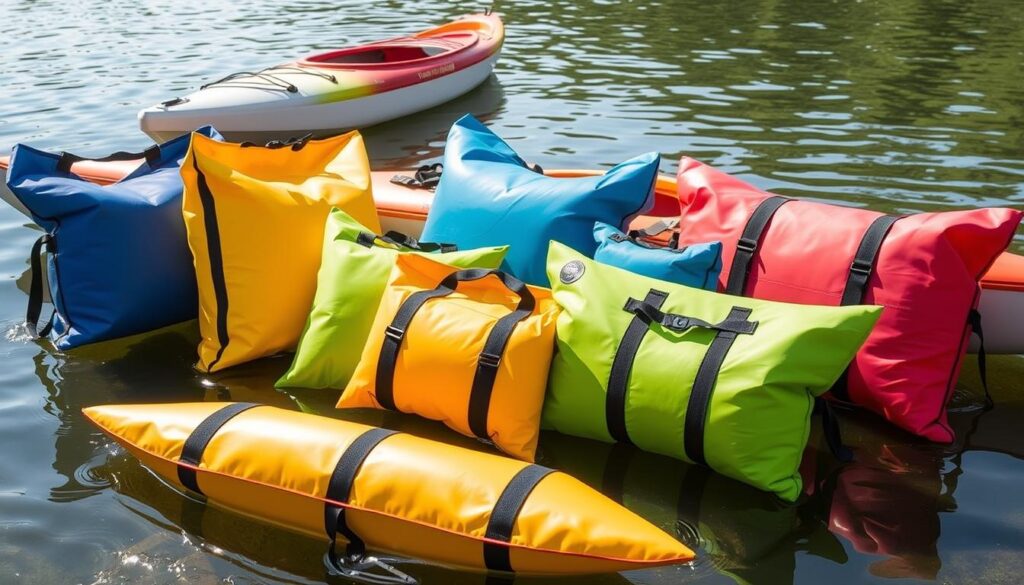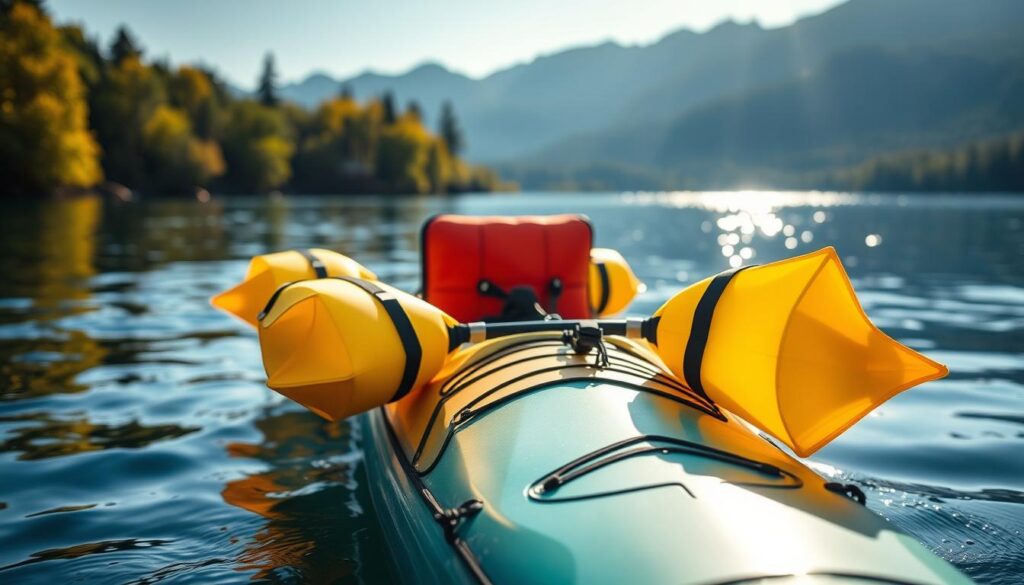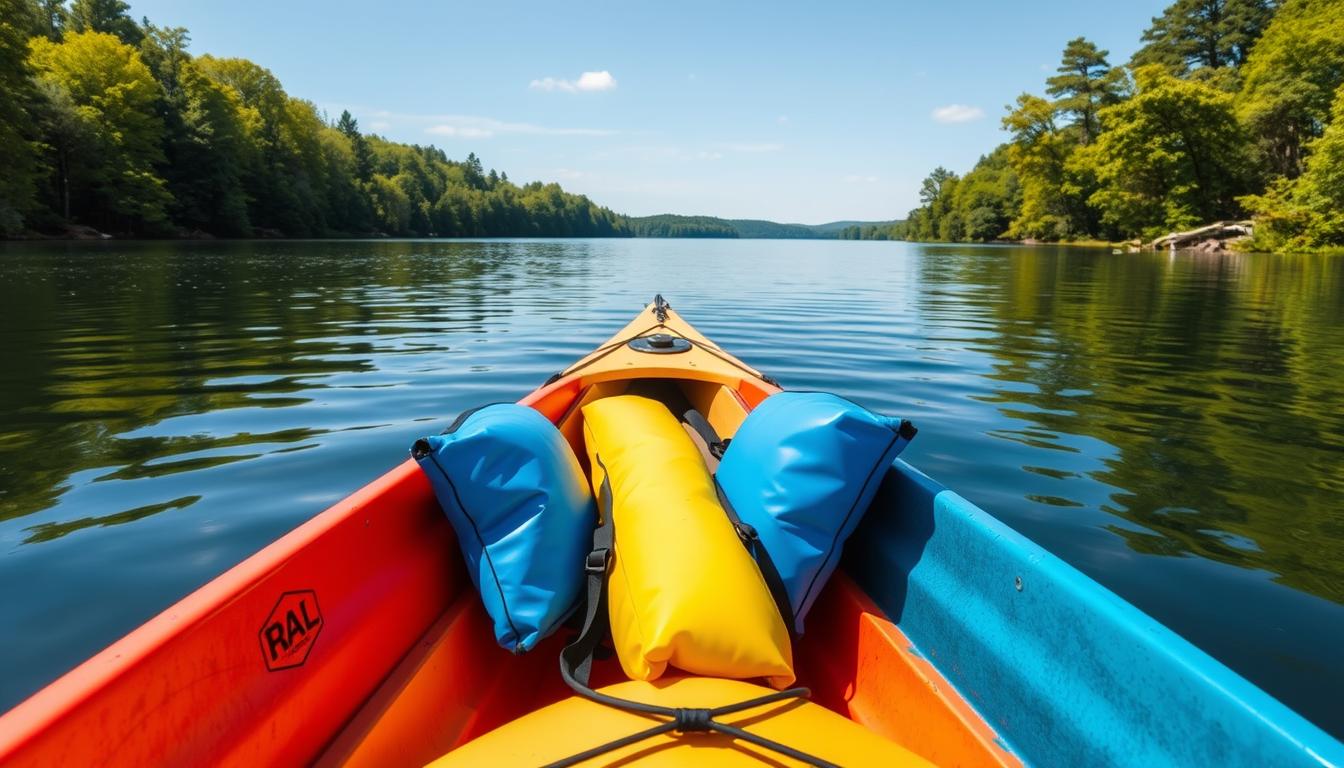
The first time I capsized in whitewater, my heart raced with pure terror. Water rushed around me, and panic set in. But then I remembered my kayak’s float bags. They were my silent guardians, keeping me safe.
Kayak float bags are more than just accessories. They’re critical safety equipment. They can mean the difference between a manageable mishap and a dangerous situation. It’s important for every paddler to know how float bags work in kayaks.
When you ask, “Do float bags work in kayaks?” the answer is yes. These devices provide crucial buoyancy. They prevent your kayak from sinking and make rescue operations easier. Kayak float bags are designed to keep your vessel afloat, creating a lifeline when challenges arise.
Key Takeaways
- Float bags are critical safety equipment for kayakers
- They prevent complete submersion during capsizing
- Kayak float bags enhance water safety and rescue potential
- Proper installation is crucial for maximum effectiveness
- Different types of float bags suit various kayaking environments
Understanding Kayak Float Bags and Their Purpose
Kayak safety equipment is key for safe water adventures. Inflatable float bags are vital for your safety, offering important features every kayaker needs to know.

Float bags are special kayak safety tools. They boost water safety and help avoid accidents. These devices have many important roles that could save a kayaker’s life in emergencies.
Basic Components of Float Bags
Kayak float bags have a few main parts:
- Durable, puncture-resistant material
- Inflation valve system
- Attachment points for secure mounting
- Lightweight and compact design
How Float Bags Enhance Water Safety
Inflatable float bags offer key safety benefits by:
- Keeping water out of the kayak
- Making the kayak more buoyant
- Improving stability in unexpected situations
- Supporting emergency flotation
Types of Kayak Float Bags Available
| Float Bag Type | Primary Use | Size Range |
|---|---|---|
| Bow Float Bags | Front compartment protection | 15-30 liters |
| Stern Float Bags | Rear compartment protection | 15-30 liters |
| Split Bags | Versatile compartment coverage | 20-40 liters |
“Safety doesn’t happen by accident. It requires preparation and the right equipment.” – Professional Kayaking Expert
Knowing about these parts and types of inflatable float bags helps you choose the right safety gear. This ensures a safer and more fun kayaking trip.
Do Float Bags Work in Kayaks: A Comprehensive Analysis

To find out if float bags work in kayaks, we need to look closely at how they perform in real life and the science behind them. These bags and stabilizers are key for staying safe on the water, especially in emergencies.
Kayaking experts have done a lot of research to see if float bags really work. They found that these safety tools are amazing in different water situations:
- They stop kayaks from sinking completely
- They give vital buoyancy in water emergencies
- They make kayaks more stable
“Float bags are not just accessories, they’re essential safety equipment for serious kayakers.” – Professional Kayaking Association
Science shows that float bags work in kayaks based on a few important things:
- How well they are installed
- The quality of the float bag material
- Choosing the right size for your kayak
Tests show that top-notch float bags can push up to 80% of water away, greatly lowering the chance of a kayak sinking. Kayak stabilizers with float bags add an extra layer of safety for paddlers of all levels.
Float bags work best when placed in the bow and stern of the kayak. This setup helps displace water and keeps the kayak afloat in tough conditions.
Essential Benefits of Using Kayak Float Bags
Kayak floatation devices are key to safe paddling. Many kayakers miss out on these important tools. They add layers of safety and boost performance.

Knowing the benefits of float bags helps you choose better safety gear and equipment.
Improved Buoyancy and Stability
Float bags make kayaking more stable. They keep your kayak balanced by:
- Keeping it from sinking fully
- Lightening it in emergencies
- Adding extra support
Water Displacement Properties
The science behind float bags is cool. They create air pockets that:
- Lessen water in your kayak
- Spread weight better
- Make your kayak easier to move
Emergency Recovery Advantages
Kayak buoyancy aids save lives in emergencies. They offer big advantages in tough situations:
| Emergency Scenario | Float Bag Benefit |
|---|---|
| Capsizing | Prevents complete submersion |
| Water Rescue | Easier location and retrieval |
| Long-Distance Paddling | Increased safety margin |
“Safety isn’t expensive, it’s priceless” – Unknown Kayaking Expert
Buying quality kayak floatation devices is more than a suggestion—it’s a must for every paddler’s safety.
Proper Installation and Placement of Float Bags
Installing float bags correctly is key for safe kayaking. They play a big role in keeping you safe on the water. Knowing how to place and install them right can protect your kayak and improve its performance.
- Measure your kayak’s interior compartments precisely
- Clean the compartment thoroughly before installation
- Inflate bags gradually to avoid overstretching
- Secure bags with attachment straps or clips
Float bags need to be placed differently on various kayak types. Whitewater kayaks often use bags at both ends. Touring kayaks might need special placement.
“Proper float bag installation is not just an accessory – it’s a critical safety measure for any kayaker.” – Professional Kayaking Safety Association
| Kayak Type | Recommended Float Bag Placement | Number of Bags |
|---|---|---|
| Whitewater Kayak | Bow and Stern | 2-3 Bags |
| Sea Kayak | Front and Rear Compartments | 2 Bags |
| Recreational Kayak | Front Compartment | 1-2 Bags |
After you install your float bags, always check them before you go kayaking. Make sure they’re inflated and securely attached. This simple check can help avoid water emergencies and give you peace of mind on your adventures.
Maintenance and Care Tips for Kayak Float Bags
Keeping your kayak gear in good shape is key. This is especially true for float bags. By following a few simple steps, you can keep your gear safe and reliable for a long time.
Cleaning and Storage Best Practices
It’s important to clean and take care of your float bags. Rinse them well with fresh water after each use. This removes salt, sand, and other debris. For a deeper clean, use mild soap and a soft cloth. Avoid harsh chemicals that can harm the material.
- Dry float bags completely before storage
- Store in a cool, dry place away from direct sunlight
- Avoid folding or compressing bags too tightly
- Keep away from sharp objects and extreme temperatures
Inspection and Replacement Schedule
Regular checks on your kayak gear are a must for safety. Before and after each trip, inspect your float bags for:
- Punctures or small tears
- Valve integrity
- Material degradation
- Loose connections
“Prevention is always better than cure when it comes to water safety equipment.” – Experienced Kayakers
Troubleshooting Common Issues
Act fast if you notice any problems with your kayak gear. Small holes can often be fixed with special patch kits. But for bigger issues or wear, it’s best to replace them.
Pro tip: Keep a repair kit with your kayak gear for on-the-spot fixes during water adventures.
Alternative Kayak Safety Equipment and Methods
Kayak safety equipment goes beyond just float bags. You need the right stabilizers and gear for your kayaking spot and skill. This ensures your safety on the water.
- Personal Flotation Devices (PFDs)
- Bilge pumps
- Rescue throw bags
- Emergency communication devices
- Waterproof safety kits
There are many kayak stabilizers to choose from. They can greatly improve your safety on the water. Let’s look at some key options:
| Safety Equipment | Purpose | Effectiveness Rating |
|---|---|---|
| Outriggers | Prevent capsizing | High |
| Sponsons | Increase lateral stability | Medium |
| Inflatable stabilization bags | Emergency buoyancy | High |
“Safety starts with preparation and the right equipment” – Professional Kayaking Association
When picking kayak safety gear, think about what you need. Professional kayakers say to use a mix of tools and techniques for safety. This way, you get the best protection.
Combining Float Bags with Other Safety Measures
Kayak safety is more than just float bags. It’s about creating a strong system of protection and being ready for anything.
Building a Complete Safety System
Good kayak safety gear is not just about float bags. You need a layered approach that includes:
- Personal flotation devices (PFDs)
- Waterproof communication devices
- Rescue throw bags
- Emergency signaling equipment
Emergency Preparedness Strategies
Float bags are more effective with a solid safety plan. Make a detailed emergency plan that covers:
- Pre-trip route communication
- Weather condition assessment
- Emergency contact notifications
- Backup navigation tools
“Preparation is the key to survival on the water.” – Professional Kayak Instructor
Training and Practice Recommendations
Getting good at kayak safety takes practice. Look for professional courses that teach rescue skills and how to use float bags.
Take time to learn how to save yourself and understand your float bags’ real-world use.
Conclusion
Exploring if float bags work in kayaks shows they are key to water safety. They make your kayaking trips safer and more stable. This is thanks to the extra buoyancy they provide.
Float bags are more than just extras; they’re essential for every kayaker. They help keep you afloat, preventing you from being fully submerged. This is crucial in case you capsize or face tough waters.
Choosing good float bags and knowing how to use them is vital. Learning about these tools boosts your confidence and safety on the water. It’s all about being prepared and knowing your gear.
Remember, float bags are just one part of staying safe while kayaking. Add them to your safety plan with training, emergency kits, and regular checks on your gear. This way, you’re ready for a fun and safe kayaking adventure.

